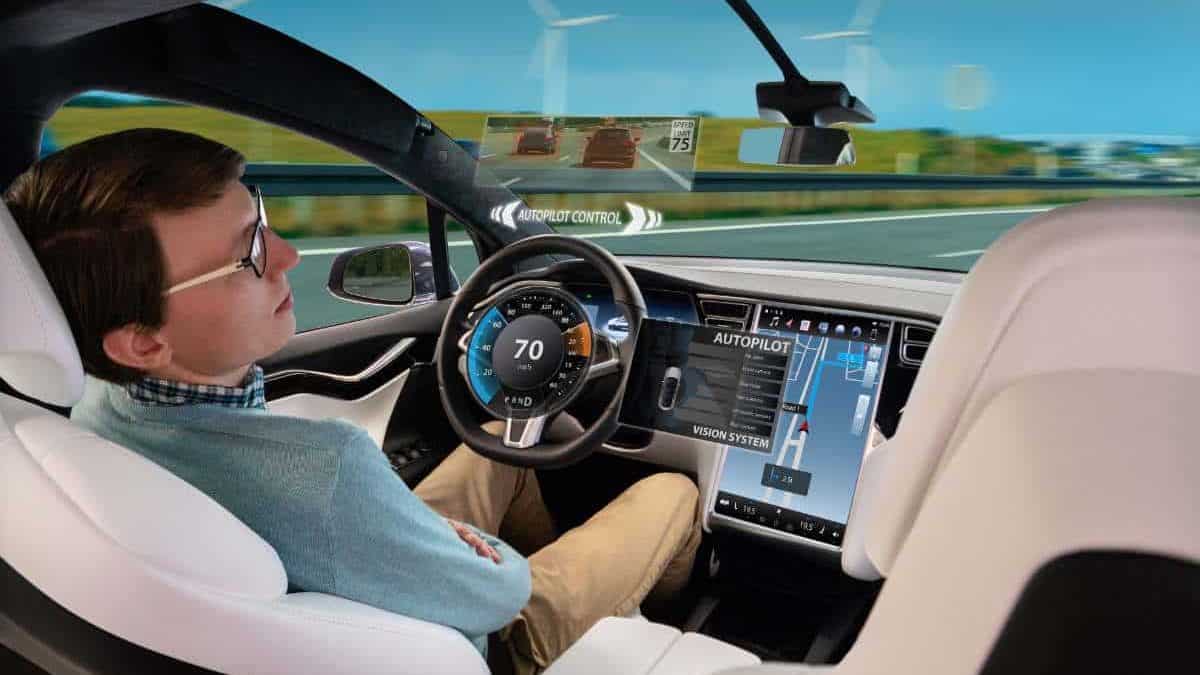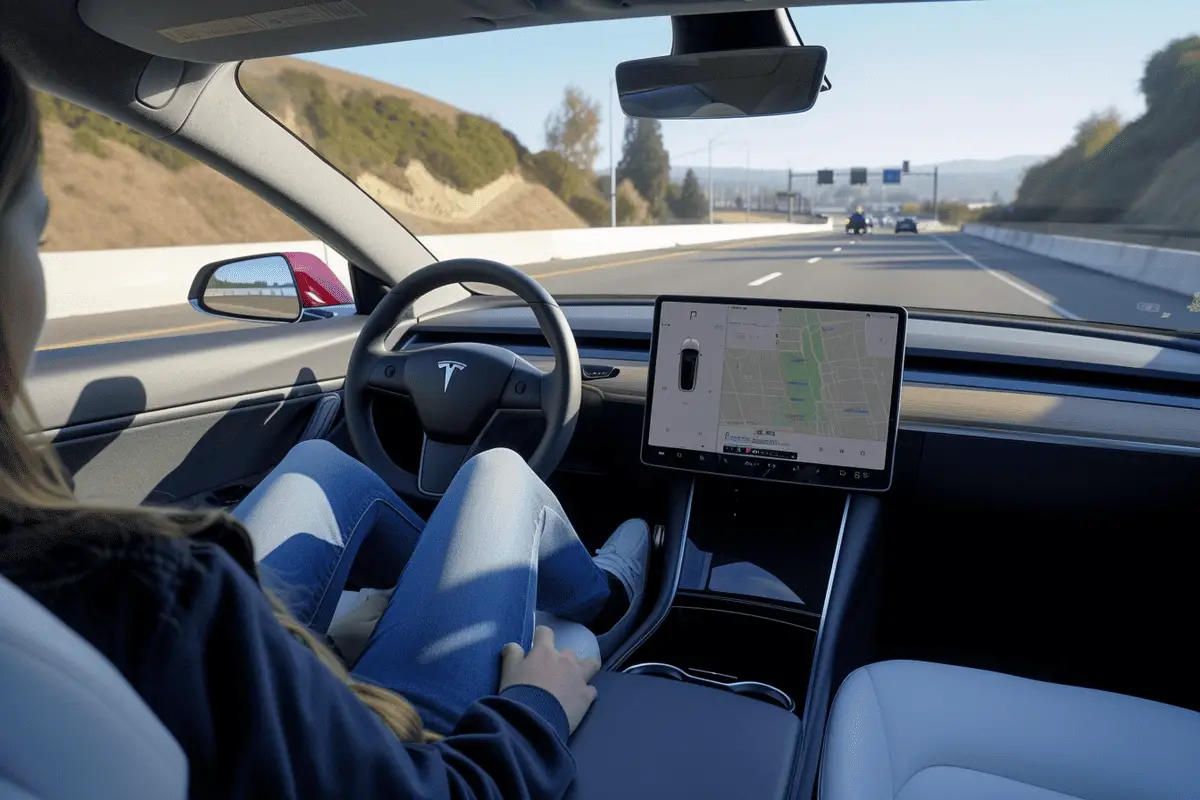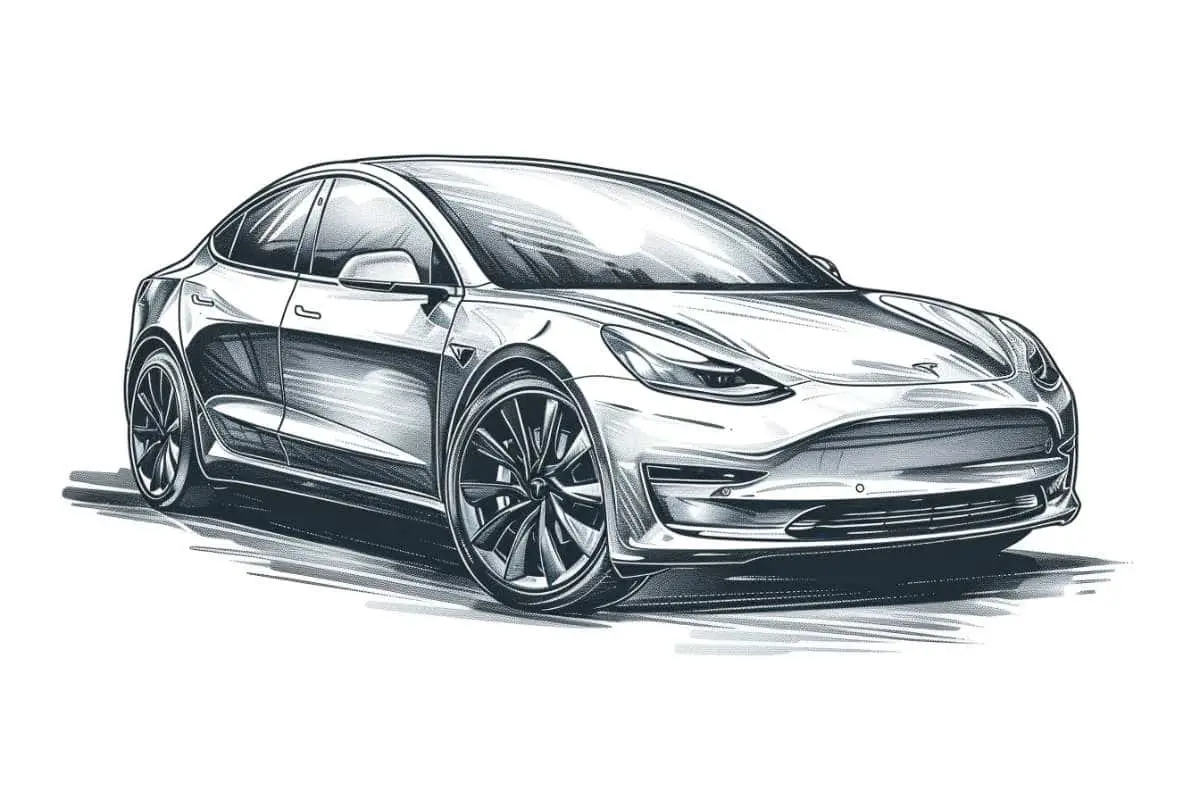Tesla’s Full Self-Driving suite, often known as FSD, has reached a new milestone with its version 12, dubbed FSD v12.
This update marks a significant development in Tesla’s quest for fully autonomous vehicles, building upon its reputation for innovative AI technology.
Tesla’s FSD technology aims to offer drivers a comprehensive self-driving experience, allowing for greater convenience and transforming our perception of personal transportation.

The FSD v12 release brings with it the promise of enhanced capabilities, integrating Tesla’s cutting-edge neural network and AI advancements to improve the driving experience.
Select Tesla owners have begun to experience these improvements firsthand as the company rolls out its latest software to a wider audience.
With this deployment, Tesla continues to refine the interaction between its software and the custom hardware found in its electric vehicles, pushing the envelope of what’s possible in the realm of autonomous driving.
Key Takeaways
- FSD Beta v12 is a notable progression in Tesla’s self-driving technology.
- Tesla’s AI and neural network advancements contribute to FSD v12’s capabilities.
- The update is being dispatched to a broader range of Tesla’s customer base.
Overview of Tesla’s Full Self-Driving (FSD) Technology

Tesla’s Full Self-Driving (FSD) suite is an advanced driver-assistance system with ambitions to achieve fully autonomous driving.
Using a combination of artificial intelligence, neural networks, and comprehensive real-world data, FSD aims to provide a unique driving experience.
Evolution of FSD Versions
Version 1 to 8 – Tesla’s initial FSD versions focused on facilitating Autopilot features, such as adaptive cruise control and lane keeping.
The company progressively introduced more capabilities through over-the-air software updates.
Version 9 – An important leap for FSD, this version represented a shift towards greater reliance on the cameras and vision systems, decreasing dependence on radar.
Version 10 – With this iteration, Tesla introduced more nuanced human-like driving behavior and finer control in city driving conditions.
Version 11 – Continued refinements occurred, focusing on driving decisions based on an expanded dataset, improved visualization, and the integration of more AI and neural network components for real-time decision-making.
Version 12 – This significant update aimed to address previous challenges and brought Tesla closer to its goal of full autonomy. It represented a profound shift in the underlying architecture, with increased reliance on machine learning and advancements in the self-driving software.
Release of FSD Version 12 (V12)

Tesla’s Full Self-Driving software has evolved significantly with the release of FSD Version 12 (V12).
This update, referred to as FSD v12, marks a significant milestone in the beta rollout, featuring major improvements and new capabilities.
Anticipated Features of FSD V12
The FSD Beta v12 is a major update, as it introduces an end-to-end neural network replacing the prior iterations of the driving stack.
This change suggests enhancements in city-streets driving capabilities.
With training on millions of video clips, the algorithm is further refined for the complex and unpredictable scenarios encountered in urban environments.
The rollout of this update started with Tesla employees, but quickly extended to a wider user base, indicative of Tesla’s confidence in this version’s progress and stability.
Comparison With Previous Version V11
The jump from the previous version V11 to V12 has been characterized by more than incremental changes.
Unlike V11, which relied on separate components for various driving tasks, V12 unifies these components into a single cohesive neural network.
This move aims to streamline decision-making processes and reduce potential conflicts between system components.
The enhanced training and iteration imply that FSD Beta v12 is significantly more advanced than its predecessors, promising smoother transitions, improved decision-making, and a user experience that pushes closer to the goal of full self-driving capabilities.
FSD Beta Testing and User Experience

Your firsthand experience helps shape the future of autonomous driving through Tesla’s Full Self-Driving (FSD) Beta program.
As a beta tester, you play a crucial role in the iterative process that hones FSD’s capabilities.
Beta Tester Participation
Beta testers like you are integral to advancing Tesla’s FSD technology.
If you’re part of this exclusive group, you’ll experience firsthand the latest advancements in self-driving technology.
Participation is often limited to a select group of customers and Tesla employees who provide real-world data to the development team.
By continuously testing new software versions in diverse driving conditions, your input contributes significantly to each subsequent update’s performance improvements.
Collecting and Utilizing Video Clips
While engaging in beta testing, your vehicle automatically captures and shares video clips with Tesla.
These clips play a strategic role in refining the FSD’s algorithms.
It’s crucial that no interventions obstruct this process, as these video feeds provide Tesla with essential visual data needed for machine learning and AI improvement, making your journeys increasingly seamless.
User Feedback and Performance Reviews
Your reviews and feedback are incredibly valuable.
The engagement doesn’t end after driving; sharing your experiences helps Tesla gauge the system’s performance and user satisfaction.
Inquiries about the frequency of necessary interventions or ease of navigational tasks become focal points for Tesla’s software updates.
Community-shared experiences and performance reviews influence not only immediate improvements but also aid in the roadmap for future FSD features.
Tesla’s Neural Network and AI Technology

Tesla is harnessing the power of advanced neural networks and AI to revolutionize the way your car understands and navigates the world.
The Role of Neural Networks in FSD
Neural networks, integral to Tesla’s Full Self-Driving (FSD) technology, act as the brains behind the driving decisions.
They are designed to mimic the way human neurons process information, enabling the vehicle to recognize and respond to diverse driving scenarios.
Tesla’s neural networks learn iteratively, fed by a constant stream of data sourced from their fleet to improve performance continuously.
End-to-End AI for Driving Decisions
Tesla employs an end-to-end AI approach, meaning their AI makes all driving decisions based on input captured through sensors and cameras.
This creates a unified system rather than disparate components working in isolation.
By harnessing neural nets, Tesla’s AI processes visual data in real-time, ensuring that the vehicle’s responses to the driving environment are both immediate and highly accurate.
Public Release and Rollout Strategy

Tesla’s Full Self-Driving (FSD) version 12 has begun its transition from a limited group test to broader public availability, with meticulous attention to safety and user feedback shaping the rollout.
Criteria for Software Rollout to Customers
Eligibility: Initially, Tesla’s FSD Beta version 12 is only available to a select group of Tesla employees and already established beta testers.
The primary criteria for rolling out to additional customers include safety data, feedback from initial users, and regulatory approval.
Feedback Integration: As the rollout progresses, Tesla monitors real-time feedback to refine the software.
Your vehicle’s telemetry contributes to this process, ensuring improvements and adjustments are made before the next stage of public release.
Timeline and Stages of Public Availability
Initial Release: The journey towards the public rollout commenced with an employee-exclusive release to iron out complexities and enhance software reliability.
Phased Approach: Following positive preliminary results, Tesla initiated the public roll-out of FSD Beta v12 in a controlled, phased manner.
- Phase 1: Rollout to a limited group of non-employee users.
- Phase 2: Subsequent releases to wider user groups based on initial phase data.
Public Release: Tesla’s rollout strategy is time-staggered, with continuous releases incrementally reaching more Tesla owners, ensuring each stage is completed with thorough validation for assured reliability and user experience.
Integration with Tesla Hardware

Tesla’s Full Self-Driving (FSD) technology continues to evolve, necessitating advanced hardware to match its capabilities.
Hardware Requirements for FSD
To utilize Tesla’s FSD, your vehicle must be equipped with specific hardware components that support the self-driving software.
All Tesla vehicles, including the Model Y and Model 3, need to have this hardware present to access FSD features.
Typically, this includes an array of cameras, ultrasonic sensors, and a computer capable of processing the data.
The Introduction of HW4
With the release of FSD version 12, Tesla has also commenced the rollout of Hardware 4 (HW4).
This new hardware suite enhances the vehicle’s processing power and sensor capabilities, designed to improve the performance and safety of Tesla’s autonomous driving features.
It’s a step beyond the current Autopilot hardware and is expected to be standard in newer Model Y and Model 3 vehicles moving forward.
For owners interested in FSD v12, Tesla Pushes FSD V12 to Hardware 4-Equipped EVs, but note that it remains in beta as Tesla continues to refine the technology.
Impact of FSD on the Future of Driving

Tesla’s Full Self-Driving (FSD) technology is poised to fundamentally transform how you experience transportation.
Changing Paradigms in Transportation
The strides in self-driving tech have signaled a paradigm shift.
With Tesla FSD, full autonomy is not a distant dream—it’s a near-future reality.
These advancements mean your daily commute could become hands-free, offering you the freedom to spend travel time on other activities.
The technology behind FSD is continually learning and improving, paving the way for a new era where autonomous driving is the norm, not the exception.
Safety and Regulatory Considerations
The promise of technology enhancing safety on the roads with FSD is significant.
Autonomous vehicles could reduce human error, which is the primary cause of road accidents.
However, extensive testing and regulatory approvals are crucial steps before widespread adoption.
It is your safety that remains at the forefront of this technological evolution, and regulatory bodies are working to ensure that before full autonomy hits the roads, it meets rigorous safety standards.
Market Response and Social Media Reactions

Tesla’s Full Self-Driving (FSD) Beta version 12 has sparked significant online commentary, with insights from both customers and market analysts shared widely across networks. Elon Musk’s engagement on platforms like Twitter further amplifies the conversation.
Customer and Analyst Opinions
FSD Beta v12 has been met with cautious optimism as well as skepticism.
Customers have taken to social media to post their experiences, showing the new features in action and commenting on the improvements.
This includes sharing videos of the FSD’s capability to perform smooth U-turns (Tesla owners posting their experiences).
On the other hand, analysts have expressed a mix of reactions; some praise the technological advancements, while others remain reserved, noting that real-world utility and regulatory approval are still hurdles to be cleared.
The livestream of Musk using FSD has been described as ‘amazing’ by some, yet it is clear there are varying levels of confidence when it comes to FSD’s impact on Tesla’s market performance.
Elon Musk and Tesla’s Social Media Strategy
Elon Musk, CEO of Tesla, is no stranger to leveraging social media to generate buzz for the company’s technology.
His active presence on platforms like Twitter often serves as a catalyst for discussion surrounding Tesla’s advancements.
Tesla’s social media strategy usually involves high engagement and direct communication from Musk, which can affect both Tesla’s stock price (TSLA) and public perception.
Consequently, the release of FSD v12 and Musk’s promotions of its capabilities have become a focal tech topic on social channels like Teslascope, and for good reason; the technological innovation in Tesla’s FSD software could be a game-changer for the automotive industry.
Global Presence and Localized Features

Tesla’s Full Self-Driving (FSD) technology adapts its performance regionally, enabling global reach while meeting local demands.
FSD Functionality in Different Regions
The functionality of FSD varies widely across different regions.
For instance, in China, features and capabilities are tailored to comply with domestic regulations and infrastructure.
Contrastingly, the system’s performance in Palo Alto, near Tesla’s headquarters, benefits from close proximity to the company’s primary innovation hub. This enables rapid updates and refinements.
- China: Adapted for local road systems and driving behavior specificities.
- Palo Alto: Often receives the latest updates first due to proximity to Tesla’s headquarters.
Adaptation to Local Traffic Conditions and Laws
Tesla’s FSD system boasts robust localization mechanisms to ensure that driving behaviors align with local traffic conditions and laws.
- Speed Limits: FSD adjusts to variable speed regulations, matching the car’s velocity to the local limits.
- Traffic Signs: Recognition and response to city-specific signage, including unique pedestrian crossing practices.
- Maneuvers: Executes driving maneuvers according to prevalent local conditions, such as overtaking protocols on highways or navigating roundabouts.
- Tesla Charger Installation Cost (Home Setups) - March 1, 2024
- Tesla Phone Key Disconnected (Troubleshooting Guide and Quick Fixes) - March 1, 2024
- Tesla FSD 12 (Explained) - March 1, 2024